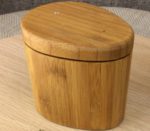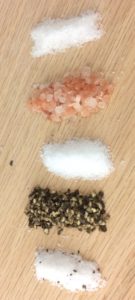Sun 25 Oct 2020
SALT CHOICES: HOW MUCH AND WHAT KIND?
Posted by DrSmokeRead other related stories: Cooking , General Smoking Information
1 Comment

Adding salt choices has a purpose and why
SALT CHOICES- HOW MUCH AND WHAT KIND?
This article was born from a question which was recently forwarded to SmokinLicious® to answer. “Why salt choices are necessary in food despite adding different ingredients even for sweet dish need(ing) salt”.
I realized just how important salt is to the style of cooking known as barbecue.
Salt Choices- Why the Need to Salt?
 Salt is a mineral found in crystalline form that is used as a seasoning for food. Simply put, salt brings out the flavor or natural essence of food. Salt choices draw out the natural juices in raw meat and dissolves with the liquid forming a brine that gets reabsorbed by the meat. This results in the meat’s ability to hold on to more of its own natural juices during cooking.
Salt is a mineral found in crystalline form that is used as a seasoning for food. Simply put, salt brings out the flavor or natural essence of food. Salt choices draw out the natural juices in raw meat and dissolves with the liquid forming a brine that gets reabsorbed by the meat. This results in the meat’s ability to hold on to more of its own natural juices during cooking.
Salt Choices- Types
Over the past 5 years, salt choices have become a very hot commodity in the food industry. There are hundreds of kinds of salts but for simplicity sake, I will discuss those that are commonly found in grocery and food specialty stores.
 Table Salt:
Table Salt:
Decades ago, this was simply known as iodized salt. This is the most refined salt that is known to have a metallic taste due to the grinding process and high-heat process to produce it. It is almost pure sodium chloride and has the highest per-granule sodium content of all salts. When used in cooking, the cook generally will use too much due to this refined grind size. I recommend you never cook with standard table salt.
Sea Salt:
This salt type is made by the evaporation of seawater which results in the retainment of natural micronutrients. Unlike table salt which uses a high-heat process, sea salt provides minerals of iodine, magnesium, calcium, potassium and bromide. There are many different grind levels in sea salt and each of those, affect the taste, color, and mouthfeel of the salt itself.
Kosher Salt:
Known for its ability to distribute evenly on the surface of food, kosher salt is harvested by mining dried up ocean and sea beds. It has a much coarser grind than table salt, which is considered flaky (For cooks, it is reliable, consistent, inexpensive, and pure).
Finishing Salt:
Just as the name implies, this type of salt is used only when a dish is finished, for instance, sliced tomato with mozzarella and basil, grilled to perfection steak, and even watermelon. Therefore, it is considered a very light tasting salt.
Tamari and Soy Sauce:
I am including tamari and soy sauce as these are very common substitutes for salts in sauces used for barbecue. Sometimes, soy sauce is used in addition to salt or garlic and onion salt for these items, making them much higher in overall sodium content. On average tamari has 700mg sodium per serving while soy sauce comes in at a whopping 1000mg per serving.
Salt Choices in Relation to BBQ Rubs & Seasonings
Hopefully, you’ve learned how to read an ingredient list on any label. The first ingredients listed make up the largest amount of the contents, while the last few ingredients make up the least. I looked at five (5) popular BBQ rubs and seasonings sold on Amazon.com to see what ingredients made up the bulk of these items and where salt rated on the ingredient list. Here are my findings:
McCormick Grill Mates Montreal Steak Seasoning – coarse salt, spices, garlic
17th Street Magic Dust All-Purpose Seasoning & Rub – salt, sugar, dextrose
Killer Hogs The BBQ Rub – brown sugar, sugar, salt
Stubb’s Beef Spice Rub – sea salt, spices, cane sugar
John Wayne Rubs – salt, garlic, sugar
As you can see, salt is a primary ingredient of commercially marketed rubs/seasonings for barbecue. Therefore, I always recommend that you give some consideration to making your own rub or seasoning. When produced in large quantity, you can keep these in the refrigerator for up to a month in an air tight container. Best of all, you’ll have the peace of mind knowing you can control the level of sodium in your meal.
We hope you found this article informative and valuable. We’d love your comments! Don’t forget to subscribe to and follow us so you don’t miss a thing. We’ll continue to bring you tips, techniques, recipes, and the science behind all things wood-fired!

More Related reading on “What Wood for Smoking” and other great smoking and grilling tips and techniques
Related reading:
-10 THINGS YOU DIDN’T KNOW YOU COULD SMOKE
-SMOKING FOODS IN FOIL: PROS & CONS
-JUST BECAUSE YOUR SMOKING (FOOD THAT IS!) DOESN’T MAKE IT ALL BAD!
Purchase products:
Smoking Wood Chunks- Double and Single Filet
Wood Chips- Grande Sapore®
Wood Chips- Minuto® and Piccolo®

Dr Smoke- “Making the right salt choices. This is the hardest part of cooking- too little or too much are both bad.”
May 3rd, 2020 at 1:56 pm
[…] -SALT CHOICES: HOW MUCH AND WHAT KIND? […]